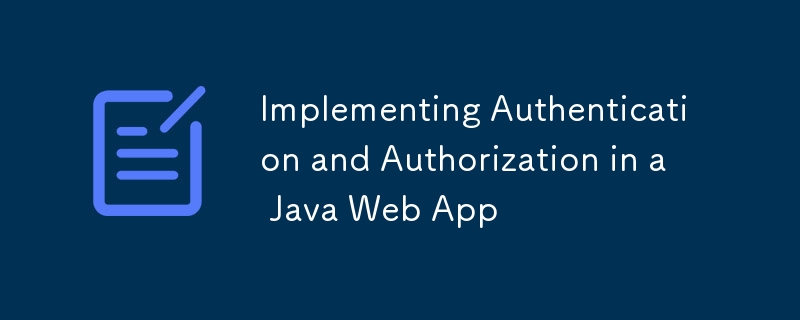Implementing Authentication and Authorization in a Java Web App
Jul 30, 2025 am 02:58 AMUse Spring Security for robust, standard-compliant authentication and authorization in Java web applications. 2. Implement authentication via form-based login or JWT for stateless APIs, ensuring passwords are hashed with BCrypt and tokens are securely managed. 3. Apply authorization using URL-level and method-level controls (e.g., @PreAuthorize) to restrict access based on roles or conditions. 4. Follow security best practices including HTTPS, secure cookies, input validation, CSRF protection, and rate limiting. 5. Avoid custom authentication mechanisms unless absolutely necessary, as they are error-prone and lack built-in safeguards. Spring Security remains the recommended solution for secure, scalable, and maintainable security implementation in Java web apps.

Implementing authentication and authorization in a Java web application is essential for securing access to resources and ensuring that only legitimate users can perform specific actions. Whether you're building a simple web app or a full-fledged enterprise system, here’s how to do it effectively using standard Java technologies and frameworks.

1. Choose the Right Framework: Spring Security (Recommended)
While you can implement security manually using servlet filters and session management, Spring Security is the de facto standard for authentication and authorization in Java web apps. It integrates seamlessly with Spring Boot and provides robust, configurable security features out of the box.
Why Spring Security?

- Handles authentication, authorization, session management, CSRF protection, etc.
- Supports multiple authentication methods (form login, OAuth2, JWT, LDAP, etc.)
- Fine-grained access control via annotations like
@PreAuthorize - Active community and extensive documentation
Add to pom.xml (for Maven):
<dependency>
<groupId>org.springframework.boot</groupId>
<artifactId>spring-boot-starter-security</artifactId>
</dependency>2. Set Up Authentication: How Users Log In
Authentication verifies who the user is. Common approaches:

Form-Based Login (Simple Username/Password)
Spring Security provides default login forms or lets you customize your own.
Example configuration:
@Configuration
@EnableWebSecurity
public class SecurityConfig {
@Bean
public SecurityFilterChain filterChain(HttpSecurity http) throws Exception {
http
.authorizeHttpRequests(authz -> authz
.requestMatchers("/public/**").permitAll()
.requestMatchers("/admin/**").hasRole("ADMIN")
.anyRequest().authenticated()
)
.formLogin(form -> form
.loginPage("/login")
.permitAll()
.defaultSuccessUrl("/home")
)
.logout(logout -> logout.permitAll());
return http.build();
}
@Bean
public UserDetailsService userDetailsService() {
UserDetails user = User.withDefaultPasswordEncoder()
.username("user")
.password("password")
.roles("USER")
.build();
UserDetails admin = User.withDefaultPasswordEncoder()
.username("admin")
.password("admin")
.roles("ADMIN")
.build();
return new InMemoryUserDetailsManager(user, admin);
}
}?? Note: Never use
withDefaultPasswordEncoder()in production. Use BCrypt instead.
JWT (Stateless Authentication)
For REST APIs or microservices, use JWT (JSON Web Tokens) instead of sessions.
Steps:
- User logs in with credentials.
- Server validates and returns a signed JWT.
- Client sends JWT in
Authorization: Bearer <token>header. - Server validates token on each request.
Use libraries like jjwt:
<dependency>
<groupId>io.jsonwebtoken</groupId>
<artifactId>jjwt-api</artifactId>
<version>0.11.5</version>
</dependency>Create a filter to intercept requests and validate JWT tokens.
3. Implement Authorization: What Users Can Do
Authorization determines what an authenticated user is allowed to do.
URL-Level Security
Restrict access based on URL patterns:
.authorizeHttpRequests(authz -> authz
.requestMatchers("/admin/**").hasRole("ADMIN")
.requestMatchers("/profile").authenticated()
.anyRequest().permitAll()
)Method-Level Security
Use annotations like @PreAuthorize:
@Service
public class UserService {
@PreAuthorize("hasRole('ADMIN') or #userId == authentication.principal.id")
public User getUser(int userId) {
// only admin or self can access
}
}Enable method-level security:
@Configuration
@EnableMethodSecurity
public class SecurityConfig { ... }4. Secure Best Practices
- ? Use HTTPS in production to protect credentials and tokens.
- ? Hash passwords using strong algorithms like BCrypt.
- ? Validate and sanitize inputs to prevent injection attacks.
- ? Set secure cookie flags (HttpOnly, Secure, SameSite).
- ? Implement rate limiting to prevent brute-force attacks.
- ? Use CSRF protection for stateful sessions (enabled by default in Spring Security).
5. Alternative: Custom Authentication (Not Recommended for Most Cases)
You can manually handle authentication using:
- Servlet filters
HttpSessionto track logged-in users- Custom login servlets
But this approach is error-prone and lacks built-in protections. Only consider it for very specific legacy needs.
Example filter snippet:
public void doFilter(ServletRequest req, ServletResponse res, FilterChain chain) {
HttpServletRequest request = (HttpServletRequest) req;
HttpServletResponse response = (HttpServletResponse) res;
if (request.getSession().getAttribute("user") == null) {
response.sendRedirect("/login");
return;
}
chain.doFilter(request, response);
}Again, prefer Spring Security unless you have a strong reason not to.
Final Notes
- For simple apps: Spring Security in-memory or database users
- For APIs: Spring Security JWT stateless setup
- For social login: Spring Security OAuth2 / OpenID Connect
Basically, use Spring Security, configure it properly, hash passwords, and always validate who can access what. It’s not trivial, but getting it right keeps your app safe.
The above is the detailed content of Implementing Authentication and Authorization in a Java Web App. For more information, please follow other related articles on the PHP Chinese website!

Hot AI Tools

Undress AI Tool
Undress images for free

Undresser.AI Undress
AI-powered app for creating realistic nude photos

AI Clothes Remover
Online AI tool for removing clothes from photos.

Clothoff.io
AI clothes remover

Video Face Swap
Swap faces in any video effortlessly with our completely free AI face swap tool!

Hot Article

Hot Tools

Notepad++7.3.1
Easy-to-use and free code editor

SublimeText3 Chinese version
Chinese version, very easy to use

Zend Studio 13.0.1
Powerful PHP integrated development environment

Dreamweaver CS6
Visual web development tools

SublimeText3 Mac version
God-level code editing software (SublimeText3)

Hot Topics
 How to disable private browsing authentication in Safari: How-to guide for iOS 17
Sep 11, 2023 pm 06:37 PM
How to disable private browsing authentication in Safari: How-to guide for iOS 17
Sep 11, 2023 pm 06:37 PM
In iOS 17, Apple introduced several new privacy and security features to its mobile operating system, one of which is the ability to require two-step authentication for private browsing tabs in Safari. Here's how it works and how to turn it off. On an iPhone or iPad running iOS 17 or iPadOS 17, if you have any Private Browsing tab open in Safari and then exit the session or app, Apple's browser now requires Face ID/TouchID authentication or a passcode to access again they. In other words, if someone gets their hands on your iPhone or iPad while it's unlocked, they still won't be able to view it without knowing your passcode
 How to implement single sign-on in PHP
Jun 11, 2023 pm 07:01 PM
How to implement single sign-on in PHP
Jun 11, 2023 pm 07:01 PM
Single sign-on (SSO) is an authentication mechanism that allows users to authenticate across multiple applications and sites using a single set of credentials, such as a username and password. This mechanism can improve user experience and efficiency while also enhancing security. In PHP, implementing single sign-on requires some specific methods. Below we will introduce how to implement single sign-on in PHP. We will divide it into the following steps: Create a user authentication center (AuthenticationCenter) using OAuth2
 Implementing user authentication using middleware in the Slim framework
Jul 29, 2023 am 10:22 AM
Implementing user authentication using middleware in the Slim framework
Jul 29, 2023 am 10:22 AM
Implementing user authentication using middleware in the Slim framework With the development of web applications, user authentication has become a crucial feature. In order to protect users' personal information and sensitive data, we need a reliable method to verify the user's identity. In this article, we will introduce how to implement user authentication using the Slim framework’s middleware. The Slim framework is a lightweight PHP framework that provides a simple and fast way to build web applications. One of the powerful features is the middle
 Token-based authentication with Angular and Node
Sep 01, 2023 pm 02:01 PM
Token-based authentication with Angular and Node
Sep 01, 2023 pm 02:01 PM
Authentication is one of the most important parts of any web application. This tutorial discusses token-based authentication systems and how they differ from traditional login systems. By the end of this tutorial, you will see a fully working demo written in Angular and Node.js. Traditional Authentication Systems Before moving on to token-based authentication systems, let’s take a look at traditional authentication systems. The user provides their username and password in the login form and clicks Login. After making the request, authenticate the user on the backend by querying the database. If the request is valid, a session is created using the user information obtained from the database, and the session information is returned in the response header so that the session ID is stored in the browser. Provides access to applications subject to
 Using JWT to implement authentication in Beego
Jun 22, 2023 pm 12:44 PM
Using JWT to implement authentication in Beego
Jun 22, 2023 pm 12:44 PM
With the rapid development of the Internet and mobile Internet, more and more applications require authentication and permission control, and JWT (JSON Web Token), as a lightweight authentication and authorization mechanism, is widely used in WEB applications. Beego is an MVC framework based on the Go language, which has the advantages of efficiency, simplicity, and scalability. This article will introduce how to use JWT to implement authentication in Beego. 1. Introduction to JWT JSONWebToken (JWT) is a
 How to use permission control and authentication in C#
Oct 09, 2023 am 11:01 AM
How to use permission control and authentication in C#
Oct 09, 2023 am 11:01 AM
How to use permission control and authentication in C# requires specific code examples. In today's Internet era, information security issues have received increasing attention. In order to protect the security of systems and data, permission control and authentication have become an indispensable part for developers. As a commonly used programming language, C# provides a wealth of functions and class libraries to help us implement permission control and authentication. Permission control refers to restricting a user's access to specific resources based on the user's identity, role, permissions, etc. A common way to implement permission control is to
 Best practices for using OAuth2 for authentication in Go
Jun 17, 2023 pm 12:13 PM
Best practices for using OAuth2 for authentication in Go
Jun 17, 2023 pm 12:13 PM
Best Practices for Using OAuth2 for Authentication in Go Language Using OAuth2 for user authentication is very common in modern web applications. This is a standard protocol that facilitates authorized access to protected resources by third-party applications. The Go language has powerful libraries that support OAuth2, allowing developers to easily implement the OAuth2 process. However, using the OAuth2 protocol correctly is not easy. This article aims to provide information on using OAuth2 for identity in Go language
 Using LDAP for user authentication in PHP
Jun 20, 2023 pm 10:25 PM
Using LDAP for user authentication in PHP
Jun 20, 2023 pm 10:25 PM
LDAP (LightweightDirectoryAccessProtocol) is a protocol for accessing distributed directory services. It can be used for tasks such as user authentication, authorization, account maintenance, and data storage. In PHP applications, LDAP can be used as a powerful authentication mechanism to provide powerful authentication and authorization functions for applications. This article will introduce how to use LDAP for user authentication in PHP. The specific content includes: Installation and configuration L






